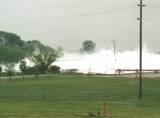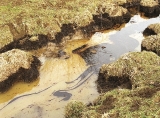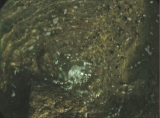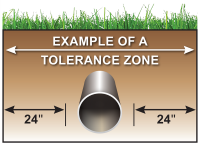SPOTTING A GAS LEAK
For your safety and the safety of others it’s important to know the signs of a natural gas release and what to do should one occur.
|
|
|
|
|

Vapor Cloud
|

Sheen on Water
|

Dead Vegetation
|

Bubbling Water
|
|
|
RECOGNIZING A PIPELINE LEAK
Natural gas is lighter than air and may pose a hazard, especially if released in confined spaces. It’s important to be able to identify signs of a natural gas leak.
|
|

|
•
|
Sight: Liquid pools, continuous bubbling in wet or flooded areas, an oily sheen on water surfaces, and vaporous fogs or blowing dirt around a pipeline area, dead or discolored plants in an otherwise healthy area of vegetation or frozen ground in warm weather are all signs of a pipeline leak. Natural gas is colorless, but vapor and “ground frosting” may be visible at high pressures. A natural gas leak may also be indicated by dust blowing from a hole in the ground or flames if the leak is ignited.
|
|
•
|
Sound: Volume can range from a quiet hissing to a loud roar depending on the size of the leak and pipeline system.
|
|
•
|
Smell: An unusual smell, petroleum odor, or gaseous odor will sometimes accompany pipeline leaks. Natural Gas and Highly Volatile Liquids are colorless, tasteless and odorless unless commercial odorants or Mercaptan is added.
|
|
If you suspect a leak, leave immediately DO NOT do the following:
Try to find or stop the leak
Touch anything electical before you leave or use a telephone, even a cell phone
Smoke
Turn applications and/or lights on and off
Operate any vehicle or equipment that could create a spark
Once you are out of the suspected area, immediately call 877-TECO PGS (877-832-6747). If the smell of natural gas is particularly strong call 911.
|
|
WHAT TO DO IN THE EVENT A LEAK WERE TO OCCUR
• Leave the area by foot immediately. Try to direct any other bystanders to leave the area. Attempt to stay upwind.
• From a safe location, call 911 or your local emergency response number and notify the pipeline operator immediately. The operator will need your name, your phone number, a brief description of the incident, and the location so the proper response can be initiated.
|
|
WHAT NOT TO DO IN THE EVENT A LEAK WERE TO OCCUR
• DO NOT cause any open flame or other potential source of ignition such as an electrical switch, vehicle ignition, light a match, etc. Do not start motor vehicles or electrical equipment. Do not ring doorbells to notify others of the leak. Knock with your hand to avoid potential sparks from knockers.
• DO NOT come into direct contact with any escaping liquids or gas.
• DO NOT drive into a leak or vapor cloud while leaving the area
• DO NOT attempt to operate any pipeline valves yourself. You may inadvertently route more product to the leak or cause a secondary incident.
• DO NOT attempt to extinguish a petroleum product or natural gas fire. Wait for local firemen and other professionals trained to deal with such emergencies.
|
|
WHAT TO DO IN CASE OF DAMAGING/DISTURBING A PIPELINE
|
|
Florida law requires you to maintain a minimum two foot clearance, or tolerance zone, on either side of the pipeline, between the point of excavation and a marked pipeline. This clearance zone begins on the outer edge of the facility.
|
|
If you cause or witness even minor damage to a pipeline or its protective coating, please immediately notify the pipeline company. Even a small disturbance to a pipeline may cause a future leak. Small disturbances can include:
Gouges
Scrapes
Dents
Creases
|

|
|
|
Any of these disturbances are cause enough for the company to inspect the damage and make repairs. Please call 877-TECO PGS (877-832-6747) if you notice any of these disturbances.
|
|
|
|
|
|
|
|
|







